-40%
1564, Austria, Emperor Ferdinand I. Silver Thaler Coin. Very Rare! PCGS XF-45!
$ 590.12
- Description
- Size Guide
Description
1564, Austria, Emperor Ferdinand I. Silver Thaler Coin. Very Rare! PCGS XF-45!Denomination: Thaler
Mint Period: 1521-1564
Mint Master: Ulrich Ursentaler
Mint Place: Hall (County of Tyrol, Austria)
Condition:
Certified and graded by PCGS as XF-45!
Reference: Davenport 8026, Moser & Tursky 220, KM-.
Rare!
Weight: 28.35gm
Diameter: 39mm
Material: Silver
Obverse:
Crowned and armored young half-length figure of Emperor Ferdinand I right, holding scepter and cword.
Legend: + FERDI . D . G . RO . VNG . BOE . DAL . CRO . Z C° . REX
Reverse:
Single-headed eagle of the County of Tyrol left with halved shield at chest bearing the arms of Spain (a turret for Castille) and Austria (striped shield of the House of Habsburg).
Legend: + INF . HISPA . ARCHIDVX . AVSTRIE . DVX . BVRG
The (
Princely
)
County of Tyrol
was an estate of the Holy Roman Empire established about 1140. Originally a jurisdiction under the sovereignty of the Counts of Tyrol, it was inherited by the Counts of Gorizia in 1253 and finally fell to the Austrian House of Habsburg in 1363. In 1804 the Princely County of Tyrol, unified with the secularised prince-bishoprics of Trent and Brixen, became a crown land of the Austrian Empire in 1804 and from 1867 a Cisleithanian crown land of Austria-Hungary. Today the territory of the historic crown land is divided between the Italian autonomous region of Trentino-Alto Adige/Südtirol and the Austrian state of Tyrol. Both parts are today associated again in the Tyrol–South Tyrol–Trentino Euroregion.
Authenticity unconditionally guaranteed
.
Bid with confidence!
Ferdinand I, Holy Roman Emperor
(Alcalá de Henares (near Madrid), Kingdom of Castile (now Spain), 10 March 1503 – Prague, Bohemia (now Czech Republic), 25 July 1564) was a Central European monarch from the House of Habsburg. His titles from birth were
Archduke of Austria
, from his father, and
Infante
of Castile, León, Aragon and Navarre from his mother.
He ruled the Austrian hereditary lands of the Habsburgs most of his public life, at the behest of his elder brother, Charles V, Holy Roman Emperor and King of Spain. Ferdinand was Archduke of Austria from 1521-1564. After the death of his brother-in-law Louis II, Ferdinand ruled as King of Bohemia and Hungary - Croatia (1526–1564). When Charles retired in 1556, Ferdinand became his successor as Holy Roman Emperor, while Spain, the Spanish Empire, Naples, Sicily, Milan, the Netherlands, and Franche-Comté went to Philip, son of Charles.
Ferdinand's motto was Fiat justitia et pereat mundus ("Let justice be done, though the world perish").
Ferdinand was born on 10 March 1503 in Alcala de Henares, 40 km from Madrid, the son of the Infanta Joanna of Castile (1479–1555), the future Queen of Castile known as
Joanna the Mad
, and Habsburg Archduke Philip
the Handsome
(1478–1506), Duke of Burgundy and future King of Castile, who was heir to Emperor Maximilian I. Ferdinand shared his birthday with his maternal grandfather Ferdinand II
the Catholic
, King of Aragon.
Charles entrusted Ferdinand with the government of the Austrian hereditary lands, roughly modern-day Austria and Slovenia. Ferdinand also served as his brother's deputy in the Holy Roman Empire during his brother's many absences and in 1531 was elected King of the Romans, making him Charles's designated heir in the Empire. Charles abdicated in 1556 and Ferdinand succeeded him, assuming the title of Emperor elect in 1558.
After Sultan Suleiman the Magnificent defeated Ferdinand's brother-in-law Louis II, King of Bohemia and of Hungary - Croatia, at the battle of Mohács on 29 August 1526, Ferdinand was elected King of Bohemia in his place. Nicolaus Olahus, secretary of Louis, attached himself to the party of King Ferdinand, but retained his position with the queen-dowager Mary of Habsburg. The throne of Hungary became the subject of a dynastic dispute between Ferdinand and John Zápolya, voivode of Transylvania. Each was supported by different factions of the nobility in the Hungarian kingdom; Ferdinand also had the support of Charles V. After defeat by Ferdinand at the Battle of Tokaj in 1527, Zápolya gained the support of Suleiman. Ferdinand was able to win control only of western Hungary because Zápolya clung to the east and the Ottomans to the conquered south. Zápolya's widow, Isabella Jagiello, ceded Royal Hungary and Transylvania to Ferdinand in the Treaty of Weissenburg of 1551. In 1554 Ogier Ghiselin de Busbecq was sent to Istanbul by Ferdinand to discuss a border treaty over disputed land with Suleiman.
The most dangerous moment of Ferdinand's career came in 1529 when he took refuge in Bohemia from a massive but ultimately unsuccessful assault on his capital by Suleiman and the Ottoman armies at the Siege of Vienna. A further Ottoman attack on Vienna was repelled in 1533. In that year Ferdinand signed a peace treaty with the Ottoman Empire, splitting the Kingdom of Hungary into a Habsburg sector in the west and John Zápolya's domain in the east, the latter effectively a vassal state of the Ottoman Empire.
In 1538, by the Treaty of Nagyvárad, Ferdinand became Zápolya's successor. He was unable to enforce this agreement during his lifetime because John II Sigismund Zápolya, infant son of John Zápolya and Isabella Jagiello, was elected King of Hungary in 1540. Zápolya was initially supported by King Sigismund of Poland, his mother's father, but in 1543 a treaty was signed between the Habsburgs and the Polish ruler as a result of which Poland became neutral in the conflict. Prince Sigismund Augustus married Elisabeth of Austria, Ferdinand's daughter.
Only 1$ shipping for each additional item purchased!












